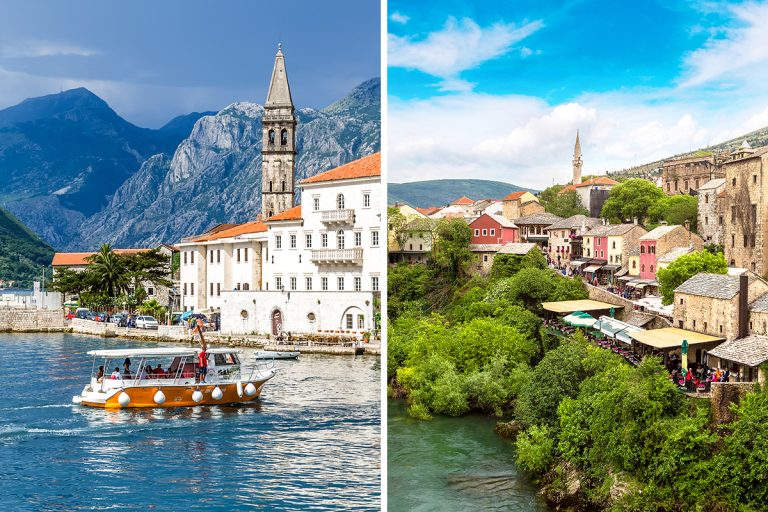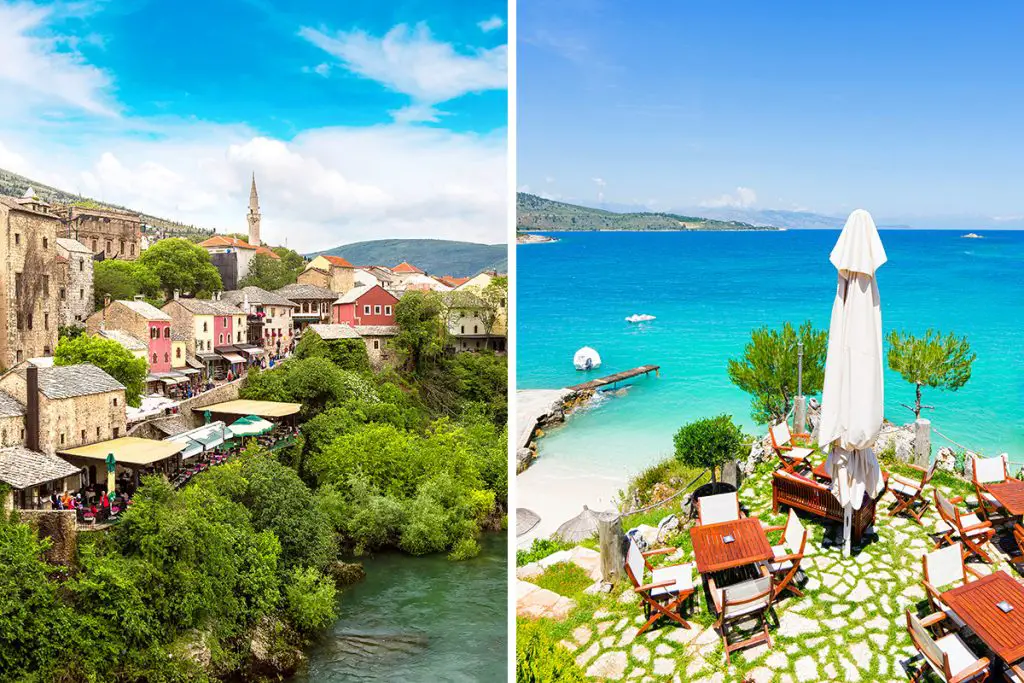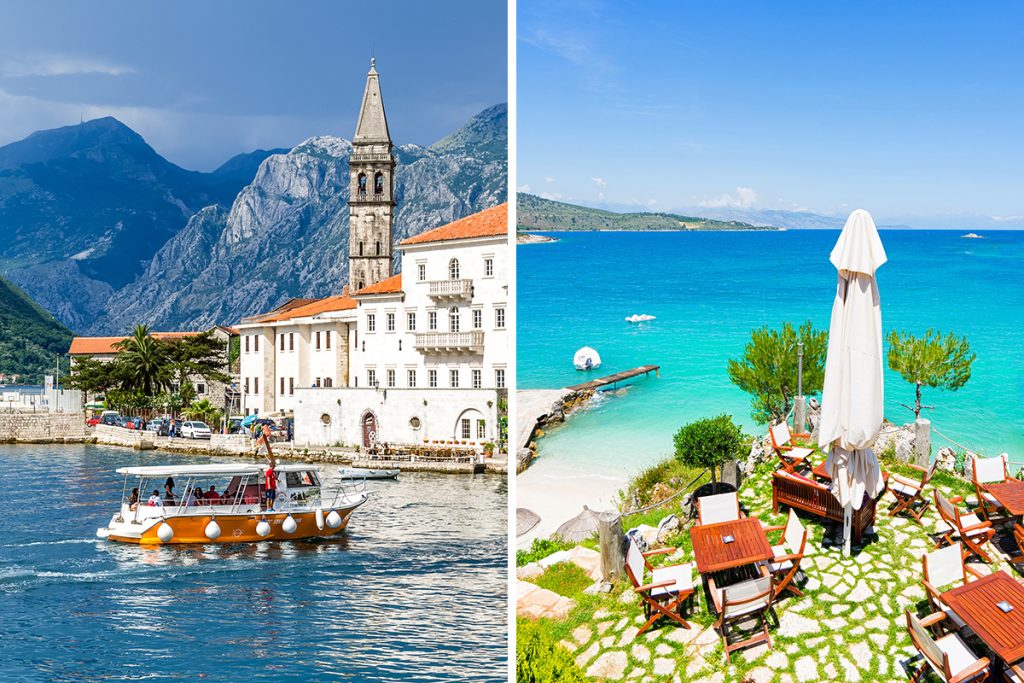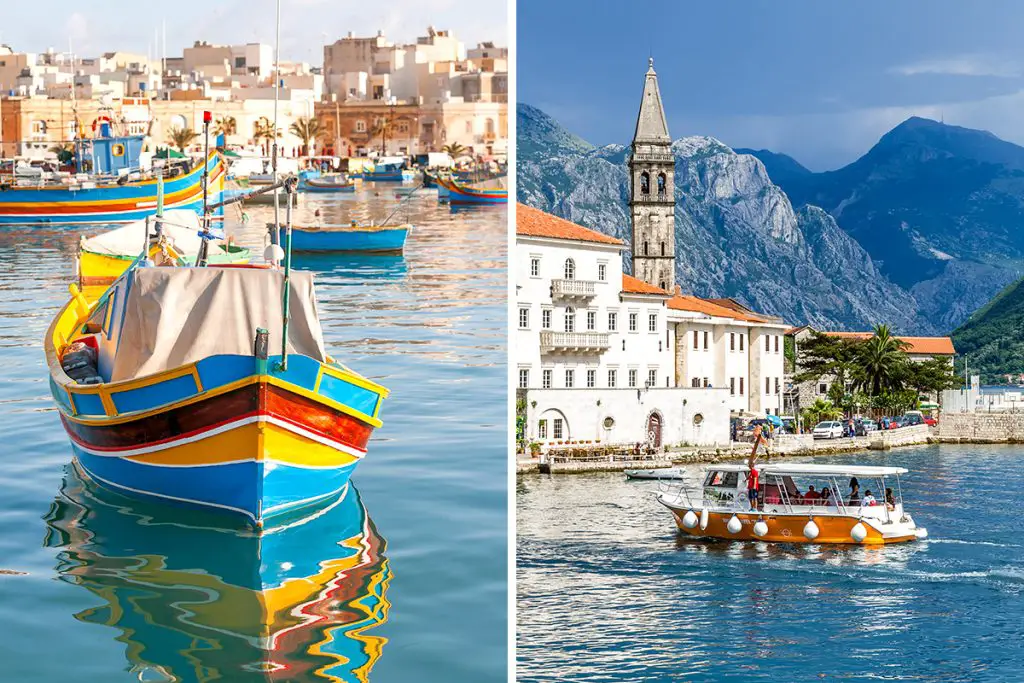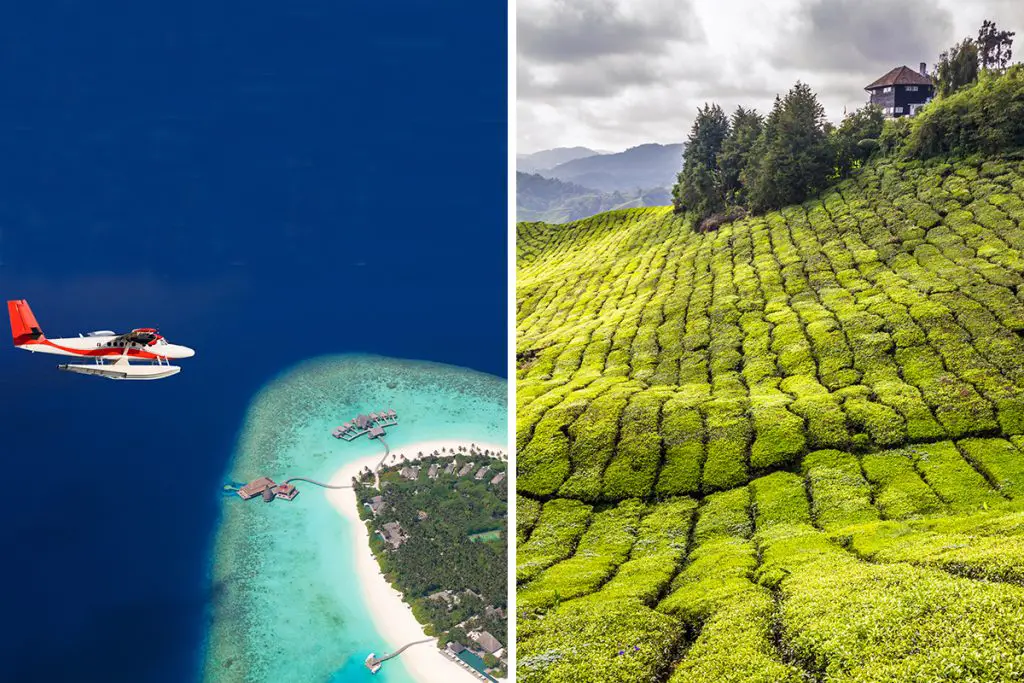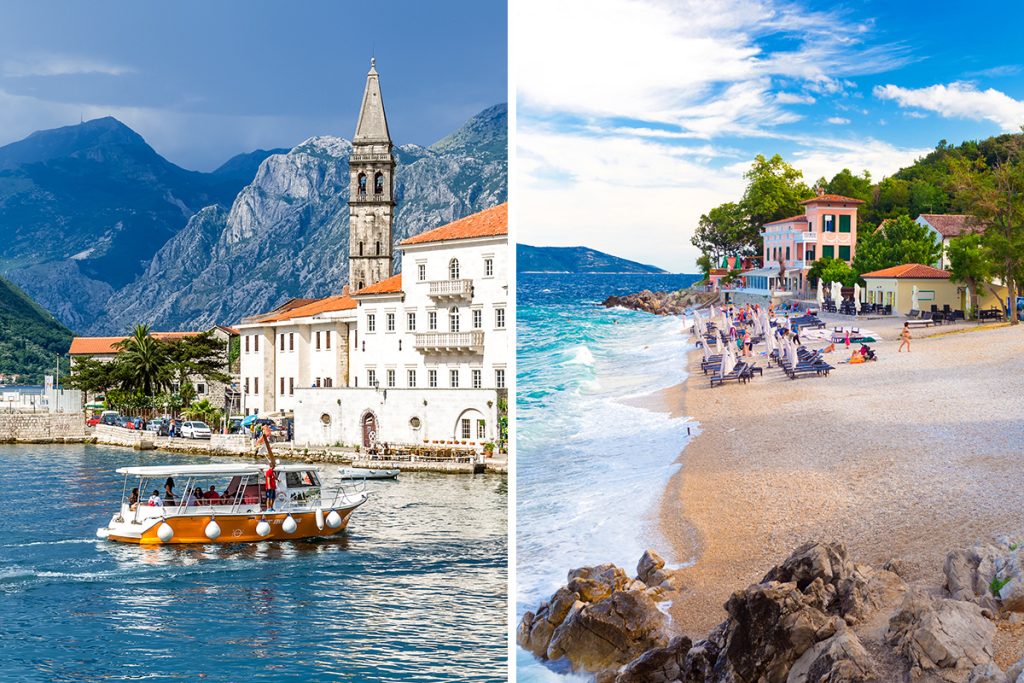Journeying through either Montenegro or Bosnia and Herzegovina is akin to stepping back in time. As you traverse through the timeworn streets, the echoes of a tumultuous past resonate through the centuries-old stone. The allure of unraveling the ancient narratives in these lands is an invitation hard to resist. Keep reading, as we delve deeper into the historic and cultural fabric of these captivating destinations.
History & Culture
Montenegro and Bosnia and Herzegovina are neighboring countries nestled in the heart of the Balkans, each with a distinct historical and cultural imprint.
Montenegro’s history is a colorful blend of Roman, Venetian, and Ottoman influences, reflected in its architectural marvels and age-old traditions. The nation’s Adriatic coast has been a crossroad of cultures, each leaving a lasting legacy.
Its storied past has shaped the Montenegrin identity, intertwining the country’s fate with the larger narrative of Mediterranean and European history.
On the flip side, Bosnia and Herzegovina has a rich tapestry of cultural influences including Ottoman, Austro-Hungarian, and Slavic. Its diverse history is mirrored in the multilingual populace and the mosaic of religious traditions that coexist harmoniously.
The enduring spirit of the Bosnian people, despite a history marred by conflict, showcases the country’s resilience and its hope for a harmonious future.
Comparing the cultural tableau of Montenegro and Bosnia and Herzegovina reveals a fascinating journey of how different empires and eras have left their mark.
While Montenegro’s narrative is deeply tied to the maritime explorations and exchanges along the Adriatic, Bosnia and Herzegovina’s story is a testament to the cross-cultural interactions inland, fostered by its geographical location at the crossroads of Western and Eastern Europe.
The allure of diving into the historical depth of Montenegro and Bosnia and Herzegovina is bound to enrich your understanding of the Balkans. Each country’s unique heritage provides a gateway to explore the kaleidoscope of cultures that have shaped this captivating region.
In summary, the historical and cultural exploration of Montenegro and Bosnia and Herzegovina offers a deeply enriching experience. Both countries open doors to bygone eras, allowing you to traverse through time and witness the evolution of cultural narratives in the Balkan heartland. Your adventure through either of these destinations will surely leave you with a treasure trove of memories and a profound appreciation for the diverse tapestry that is Balkan history.
Attractions & Activities
Venturing into the heart of the Balkans, Montenegro and Bosnia and Herzegovina offer a myriad of attractions and activities that beckon the curious traveler. The ancient whispers and modern calls of adventure blend seamlessly, painting a vibrant backdrop for an unforgettable exploration.
In Montenegro, the old town of Kotor, a UNESCO World Heritage site, invites you to wander through its medieval maze of cobblestone streets. The awe-inspiring Bay of Kotor, encircled by towering cliffs, offers an ideal setting for boat tours and kayaking adventures.
Further inland, the Tara River Canyon, the deepest canyon in Europe, provides thrilling white-water rafting opportunities. The country’s historical narrative unfolds as you explore the royal capital of Cetinje, with its array of museums and monuments portraying Montenegro’s illustrious past.
Contrastingly, Bosnia and Herzegovina boasts a blend of the untouched and the historically significant. The iconic Stari Most (Old Bridge) in Mostar is a symbol of reconciliation and a sight to behold. The picturesque Kravice Waterfalls offer a serene escape, where you can marvel at the natural beauty.
For a more solemn experience, the remnants of the war era, showcased in Sarajevo’s Tunnel of Hope and Gallery 11/07/95, provide a deep dive into the nation’s recent history.
Between the two, a plethora of hiking and biking trails await. While Montenegro’s Lovćen National Park and Biogradska Gora National Park offer scenic trails through diverse landscapes, Bosnia and Herzegovina’s Sutjeska National Park and Via Dinarica trail provide equally enchanting outdoor escapes.
Both countries boast a wealth of outdoor activities and historical sites that promise a rich and varied experience. Whether it’s the pristine natural beauty or the ancient, stone-clad towns, each destination offers a unique slice of the Balkans.
In essence, the tapestry of attractions and activities in Montenegro and Bosnia and Herzegovina is vast and varied. Your exploratory desires will find a haven in the midst of the ancient and the natural, each day promising a new adventure waiting to be discovered.
Beaches
The allure of the Adriatic coastline is a distinguishing feature when comparing Montenegro and Bosnia and Herzegovina. The gentle lapping of waves against a rugged coastline provides a tranquil escape.
Montenegro’s stretch of Adriatic coast is adorned with pebbly beaches and quaint coastal towns. The Budva Riviera, spanning about 35 kilometers (21.7 miles), is dotted with several serene beaches like Mogren and Jaz, where the crystal clear waters invite you for a refreshing dip.
Not far from Budva, the picturesque Sveti Stefan island with its pink sandy beaches offers a more secluded retreat.
Bosnia and Herzegovina, on the other hand, has a modest coastline of only 20 kilometers (12.4 miles) along the Adriatic Sea. The small town of Neum is the nation’s gateway to the sea, offering a peaceful beach experience. While the beach options are limited compared to Montenegro, the tranquil ambiance of Neum provides a quiet escape from the hustle and bustle.
The pristine waters of the Adriatic are a shared treasure yet the experience of basking on its shores varies markedly between Montenegro and Bosnia and Herzegovina. Montenegro’s extensive coastline offers a wider array of beach experiences, while Bosnia and Herzegovina provides a snippet of Adriatic charm.
To sum up, the contrasting beach landscapes of Montenegro and Bosnia and Herzegovina mirror the distinct experiences they offer. Montenegro’s expansive coastline invites a more varied beach escapade, while the secluded shores of Bosnia and Herzegovina promise a peaceful retreat, making each destination unique in its appeal to beach enthusiasts.
Eating, Drinking & Nightlife
The culinary scene of Montenegro and Bosnia and Herzegovina is a delightful exploration into the Balkan’s rich tradition of food and beverages. It’s a journey of flavors that narrates tales of historical interactions and local ingenuity.
In Montenegro, the eating experience is an homage to its Mediterranean and Adriatic influences. Seafood plays a starring role, with dishes like black risotto and grilled fish finding a regular place on the menu. The country’s mountainous terrain also contributes to its culinary diversity, with smoked ham from Njeguši being a prized local delicacy.
Bosnia and Herzegovina, on the other hand, offers a hearty fare with Ottoman traces. Dishes like ćevapi (small grilled minced meat), sogan-dolma (stuffed onions), and pita (filled pastry) showcase a delightful fusion of Eastern European and Middle Eastern flavors.
When it comes to drinking, Montenegro’s vineyards gift the palate with a variety of local wines, like Vranac, which is deeply rooted in the Montenegrin soil. The tradition of winemaking here goes back centuries, providing a delightful sip of history.
In Bosnia and Herzegovina, coffee culture is a significant aspect of social life. The ritual of drinking coffee, often extending over hours, embodies the nation’s laid-back attitude. Rakija, a potent fruit brandy, is another beverage that holds a special place in the Bosnian drinking culture.
As the day transitions into night, Montenegro’s coastal towns like Budva become lively with an array of bars and clubs offering a vibrant nightlife. It’s a place where the Mediterranean zest for life shines.
Bosnia and Herzegovina’s nightlife is more subdued but no less engaging, with Sarajevo and Mostar offering a range of quaint cafes and bars where locals and visitors mingle till the early hours.
In a nutshell, whether it’s the taste of the Adriatic in Montenegro or the hearty Bosnian fare, the variety in eating, drinking, and nightlife between these two destinations is a reflection of their unique cultural tapestries. Each offers a different yet equally captivating night under the Balkan stars.
Shopping
The retail landscape in Montenegro and Bosnia and Herzegovina is a blend of the traditional and the modern, offering a peek into the local life and craftsmanship.
Montenegro offers a range of shopping experiences from modern shopping centers like Delta City and Mall of Montenegro in Podgorica to quaint markets and boutiques in coastal towns like Budva and Kotor. Here, you can find locally made products such as olive oil, wine, and handcrafted jewelry that echo the Montenegrin culture.
On the other side, Bosnia and Herzegovina exudes an old-world charm in its shopping scene.
The Baščaršija market in Sarajevo is a living testament to the city’s Ottoman past, where coppersmiths and artisans display their craftsmanship in small, quaint shops. Items like handcrafted copperware, traditional carpets, and Bosnian coffee sets are among the treasures you can discover.
Both countries offer a range of souvenirs that encapsulate their unique heritage. Montenegro’s offerings are often tied to its maritime culture, while Bosnia and Herzegovina showcases its rich historical tapestry through its artisanal products.
In Podgorica and Sarajevo, the capitals, modern shopping malls provide a contrast to the traditional markets, giving you a taste of the contemporary local lifestyle.
Summarily, shopping in Montenegro and Bosnia and Herzegovina is a delightful dive into the past and present. Whether it’s the modern malls or the charming old markets, each purchase tells a story of the land’s rich cultural blend and offers a tangible memory to carry back home.
Accommodation
The choices of accommodation in Montenegro and Bosnia and Herzegovina reflect the essence of their respective cultures and landscapes. Whether nestled in the heart of ancient towns or perched alongside pristine waters, the range of stay options invites you to experience the Balkans’ warm hospitality.
In Montenegro, the accommodation spectrum spans from luxury resorts in the coastal towns of Budva and Sveti Stefan to quaint stone villas in the historical Kotor Bay. The unique Montenegrin charm is echoed in the traditional architecture and modern amenities these places offer.
Conversely, Bosnia and Herzegovina provides a more rustic lodging experience. Characteristic Ottoman-style inns known as Han, and Austro-Hungarian-themed hotels in Sarajevo and Mostar offer a step back into history. The picturesque surroundings often become a part of the experience, especially in places like the quaint guesthouses along the river in Mostar.
Both countries offer a variety of modern hotel chains in their capital cities, Podgorica and Sarajevo respectively, catering to travelers looking for familiar comfort with a touch of local flavor.
The choice between a modern or traditional lodging experience, set against a backdrop of historical or natural beauty, is what sets these destinations apart in terms of accommodation.
In conclusion, the accommodation in Montenegro and Bosnia and Herzegovina extends beyond mere stay options, offering a glimpse into the rich history and beautiful landscapes that define these Balkan neighbors.
Family-Friendliness & Children’s Activities
Both Montenegro and Bosnia and Herzegovina welcome families with a blend of engaging activities and family-friendly atmospheres. The essence of Balkan hospitality shines through, making family vacations enjoyable and memorable.
Montenegro’s diverse landscapes offer a playground for families. Be it exploring the ancient walls of Kotor, enjoying a tranquil boat ride across Skadar Lake, or embarking on a scenic train journey through the mountains, there’s an array of experiences that cater to young minds.
In Bosnia and Herzegovina, family-friendly excursions lean more towards exploring the rich history and natural beauty. A stroll through the old bazaars, exploring the historical edifices of Sarajevo and Mostar, and enjoying a peaceful day by the Pliva Lakes are some of the activities that families can indulge in.
The open-air museums, nature parks, and interactive historical sites in both countries provide an enriching and educational experience for children, making learning fun and engaging.
Both countries embody a family-friendly ethos, ensuring that the needs of younger travelers are well catered to, making the trip enjoyable for everyone.
In sum, the family-centric culture of Montenegro and Bosnia and Herzegovina, combined with a plethora of engaging activities, promises a rewarding family vacation experience in the heart of the Balkans.
Getting There & Getting Around
The journey to Montenegro and Bosnia and Herzegovina, followed by the ease of traversing through their picturesque landscapes, is a precursor to the adventures that await.
Getting to Montenegro is relatively straightforward with two international airports, Tivat and Podgorica, welcoming flights from various European destinations. The country’s compact size, about 13,812 square kilometers (5,333 square miles), allows for easy travel between cities and towns.
In contrast, Bosnia and Herzegovina is served by international airports in Sarajevo, Mostar, and Tuzla. The larger land area of 51,197 square kilometers (19,767 square miles) presents a longer travel time between different regions.
When it comes to getting around, Montenegro boasts a well-maintained road network, making self-drive a popular option. Additionally, the scenic Bar to Belgrade railway offers a unique travel experience across Montenegro’s picturesque landscapes.
Bosnia and Herzegovina has a less developed but functional transportation infrastructure. Buses are the primary mode of inter-city travel, providing an economical way to explore the country. The train network, although limited, provides a picturesque journey through the heartland.
Both countries offer a distinctive travel experience, with Montenegro’s modern infrastructure contrasting with Bosnia and Herzegovina’s rustic charm, yet both provide a gateway to explore the Balkan’s enchanting landscapes.
Weather
The weather in Montenegro and Bosnia and Herzegovina plays a significant role in shaping the experience of your visit. The distinct climatic conditions in each country contribute to their unique allure and offer a variety of experiences throughout the year.
Montenegro experiences a Mediterranean climate along its coast, with warm summers and mild winters. The summer months from June to August see temperatures ranging from 70°F to 95°F (21°C to 35°C). The coastal areas remain pleasant even in the winter months of December to February, with temperatures hovering around 45°F to 55°F (7°C to 13°C).
On the other hand, Bosnia and Herzegovina experiences a continental climate. The summers, particularly from June to August, are warm with temperatures between 70°F to 86°F (21°C to 30°C), while the winters, spanning December to February, are colder with temperatures often dropping to 32°F to 45°F (0°C to 7°C).
Montenegro’s mountainous regions follow a sub-alpine climate, with cooler summers and snowy winters. This is quite similar to the higher elevations in Bosnia and Herzegovina, where winters are snow-laden, offering a contrasting yet beautiful vista.
Both countries showcase a beautiful array of seasonal changes, where spring and autumn bring a medley of colors, enhancing the charm of the historical towns and natural landscapes.
In summary, the weather in Montenegro and Bosnia and Herzegovina is a palette of varied climatic conditions. Depending on the season of your visit, each country presents a unique atmosphere, enriching your Balkan exploration.
Safety
Safety is a paramount concern while planning a trip, and understanding the safety scenario in Montenegro and Bosnia and Herzegovina can contribute to a hassle-free experience.
Generally, Montenegro is considered safe for tourists. The country has a low crime rate, and incidents of violent crime are rare. The local authorities are keen on maintaining a safe environment for both locals and visitors.
Similarly, Bosnia and Herzegovina also boasts a low crime rate against tourists. The locals are known for their hospitality, and the overall atmosphere is welcoming.
In terms of unique non-crime-related safety topics, it’s worth noting that both countries have demining activities due to past conflicts. However, these areas are well-marked, and sticking to well-trodden paths is advised.
Both Montenegro and Bosnia and Herzegovina have efficient emergency services, ensuring help is at hand in case of any untoward incidents.
In conclusion, Montenegro and Bosnia and Herzegovina are relatively safe destinations with supportive local communities and authorities. Being aware of your surroundings and following standard safety precautions can contribute to a smooth and enjoyable visit.
Cost
The cost of visiting Montenegro and Bosnia and Herzegovina is an aspect that shapes your travel experience. A comparative look at the expenses involved in exploring these beautiful Balkan nations provides insight into budgeting for your adventure.
In Montenegro, 3-course meals at a mid-range restaurant may cost around €17 (approximately $18.10), while a similar meal in Bosnia and Herzegovina might range from €13 (approximately $13.66 to $13.84).
When it comes to lodging, a night in a standard 3-star hotel in Montenegro could be around $117, whereas in Bosnia and Herzegovina, it might cost slightly less, ranging from $60.
Transportation within Montenegro, be it by bus or taxi, is relatively affordable, with short taxi rides around €5 to €10 (approximately $5.30 to $10.60). On the other hand, Bosnia and Herzegovina offers an even more economical transportation cost with local bus fares as low as €1 to €2 (approximately $1.06 to $2.13).
Both countries present a different cost spectrum, with Montenegro being slightly on the higher end compared to Bosnia and Herzegovina, yet both offer value for the experiences they provide.
Which Is Better – Montenegro or Bosnia and Herzegovina?
The decision between exploring Montenegro or diving into the diverse realm of Bosnia and Herzegovina can be akin to choosing between two different yet equally enchanting narratives. The contrasting tapestry of experiences each country offers creates a compelling case for both.
Montenegro’s rich blend of Roman, Venetian, and Ottoman influences sets a vibrant backdrop for exploring historical architecture and maritime adventures. Its pristine coastline and the old town charm, especially in places like Kotor, provide a walk through the lanes of history while enjoying the serene beauty of the Adriatic.
Bosnia and Herzegovina, on the other hand, offers a medley of Ottoman, Austro-Hungarian, and Slavic cultural imprints. The historic towns of Sarajevo and Mostar are testaments to the country’s enduring spirit and its rich, diverse history.
When it comes to attractions and activities, the two countries showcase a rich palette of experiences. Montenegro’s scenic beauty, epitomized by the Bay of Kotor and Tara River Canyon, offers a blend of relaxation and adventure. Bosnia and Herzegovina, with its iconic Stari Most bridge and the serene Kravice Waterfalls, presents a more rustic and tranquil getaway.
The beach experience in Montenegro with its expansive coastline offers a more varied escapade compared to the secluded shores of Bosnia and Herzegovina. The latter, with its limited but peaceful coastline, promises a quiet retreat from the bustling world.
The culinary exploration in both countries is a journey through their historical interactions and regional flavors. Whether it’s the Mediterranean-influenced seafood delicacies in Montenegro or the hearty Bosnian fare that traces its roots to Ottoman cuisine, the taste buds are in for a delightful experience.
The aspects of accommodation, family-friendliness, and ease of getting around further delineate the experiences. Montenegro, with its range of luxury resorts to quaint villas, provides a more modern stay experience, while Bosnia and Herzegovina offers a step back in time with Ottoman-style inns and Austro-Hungarian-themed hotels.
The family-centric activities, whether exploring the ancient edifices or enjoying a boat ride on placid lakes, ensure an enriching vacation for families in both countries.
In conclusion, the choice between Montenegro and Bosnia and Herzegovina hinges on personal preferences. For those seeking a blend of historical exploration with a touch of maritime adventure, Montenegro is a prime choice. However, if a journey through diverse cultural landscapes intertwined with a rustic charm is what piques your interest, then Bosnia and Herzegovina is the destination to gravitate towards.
Each country, with its unique offerings, promises a memorable Balkan adventure filled with discoveries, serenity, and the warm embrace of history and nature.

